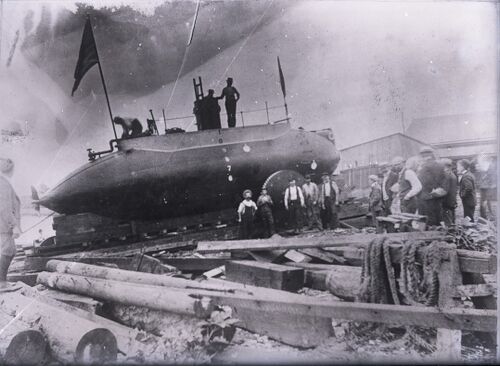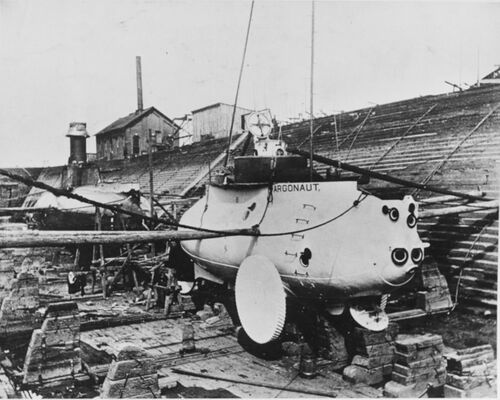Argonaut 1: Difference between revisions
Pbcjohnston (talk | contribs) updated email at bottom |
Pbcjohnston (talk | contribs) mNo edit summary |
||
| Line 11: | Line 11: | ||
This photo shows Argonaut 1 in drydock at the Columbian Iron Works facility at Locust Point, near Fort McHenry, in Baltimore, Maryland in approximately 1898. The large forward wheels and view ports at the bow are very apparent. Just below the forward view ports is the open diver's hatch. In this photo, Simon Lake has installed a circular gasoline tank topside around the conning tower. Having the gasoline tanks outside of the pressure hull was favored by Lake, who thought (rightfully so) that it was too dangerous to have them internally. This was an unusual place to put them, but it worked for this small boat. | This photo shows Argonaut 1 in drydock at the Columbian Iron Works facility at Locust Point, near Fort McHenry, in Baltimore, Maryland in approximately 1898. The large forward wheels and view ports at the bow are very apparent. Just below the forward view ports is the open diver's hatch. In this photo, Simon Lake has installed a circular gasoline tank topside around the conning tower. Having the gasoline tanks outside of the pressure hull was favored by Lake, who thought (rightfully so) that it was too dangerous to have them internally. This was an unusual place to put them, but it worked for this small boat. | ||
It is interesting to note that there is another submarine in the dock with the Argonaut. Behind her is the Holland submarine Plunger of 1895, also known as the Holland V. It was an experimental submarine built by Holland under a Navy contract. Steam boiler powered, it was a complete failure and it was never accepted by the Navy or commissioned into service. Never completely finished it lingered at the Holland facility at New Suffolk, NY until it was scrapped in 1917. | It is interesting to note that there is another submarine in the dock with the Argonaut. Behind her is the Holland submarine Plunger of 1895, also known as the Holland V. It was an experimental submarine built by Holland under a Navy contract. Steam boiler powered, it was a complete failure and it was never accepted by the Navy or commissioned into service. As far as can be determined it never actually got underway under its own power. Never completely finished it lingered at the Holland facility at New Suffolk, NY until it was scrapped in 1917. | ||
<small>Photo NH 57030 courtesy of NHHC.</small> | <small>Photo NH 57030 courtesy of NHHC.</small> | ||
Revision as of 18:30, 30 June 2024

Photo NH 89470 courtesy of NHHC.

This photo shows Argonaut 1 in drydock at the Columbian Iron Works facility at Locust Point, near Fort McHenry, in Baltimore, Maryland in approximately 1898. The large forward wheels and view ports at the bow are very apparent. Just below the forward view ports is the open diver's hatch. In this photo, Simon Lake has installed a circular gasoline tank topside around the conning tower. Having the gasoline tanks outside of the pressure hull was favored by Lake, who thought (rightfully so) that it was too dangerous to have them internally. This was an unusual place to put them, but it worked for this small boat.
It is interesting to note that there is another submarine in the dock with the Argonaut. Behind her is the Holland submarine Plunger of 1895, also known as the Holland V. It was an experimental submarine built by Holland under a Navy contract. Steam boiler powered, it was a complete failure and it was never accepted by the Navy or commissioned into service. As far as can be determined it never actually got underway under its own power. Never completely finished it lingered at the Holland facility at New Suffolk, NY until it was scrapped in 1917.
Photo NH 57030 courtesy of NHHC.
Page created by:
Ric Hedman & David Johnston
1999 - 2023 - PigBoats.COM©
Mountlake Terrace, WA, Norfolk, VA
webmaster@pigboats.com
